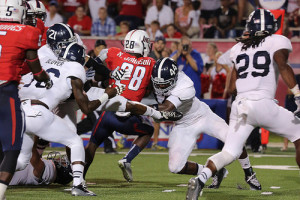
Impact sports present a distinct threat to children and adult players: head trauma. The statistics are staggering. Head injuries, including concussions from high-impact sports, such as football and baseball, are the cause for thousands of emergency room visits each year. Some cases are so severe that the injured players suffer from unintended side effects for the rest of their lives.
Researchers know that repeated head injuries over time, as well as even just one instance of severe impact, can lead to life-altering damage, and even death. Experts in head trauma agree that 20G hits can cause damage, but it’s not just the force that makes a difference. The location and type of impact matters, too. Luckily, technological innovation has risen to the challenge of tracking hits, and promises a new way to prevent lasting brain injury that results from head trauma.
Tracking Hits in the Head
If you know what and how many hits an athlete suffers, you can more easily evaluate their total health, along with the likelihood of long-term injury. The Hit Count program, an initiative of the nonprofit Concussion Legacy Foundation, provides the industry standard that players, families, and experts can use to measure head injury and make informed decisions. Hit Count-certified devices use sensors to measure the force of impact and record hits delivered with more than 20G of force.
In research studies, helmet sensors have recorded more than 1.5 billion impacts to the heads of American youth and high school football players. While Hit Count can’t prevent impacts from occurring in the present moment, it can help coaches, parents, and others create safer playing practices to prevent future problems related to head trauma. Knowing when and how hits occur provides the first step in determining how to stop them. Some players may experience hits as impactful as a minor (or major!) car accident.
How to Use Hit Count in Your Community
If you’re interested in exploring the Hit Count program, it’s easy to get involved. There are Hit Count certified products that have undergone extensive testing to ensure accordance with industry standards and accuracy that you can explore integrating as part of your sports program. The technology features more accurate sensors than many of the monitoring systems currently on the market, making the certified label an important part of future purchases.
GForce Tracker, one of the certified companies, currently produces helmets with Hit Count technology. Parents can also purchase Triax SIM-certified devices to place in helmets, or they can purchase helmets with the technology already installed. Triax provides the unique ability for users to monitor recordings through a mobile app, making future decisions about player safety faster and easier.
Sensors such as Triax’s headband model run close to $200 per device, but if the device helps identify unsafe behaviors, and promotes safety throughout the sports industry, that price tag doesn’t seem quite as steep. Other companies that offer Hit Count certified products and sensors include i1Biometrics, Impakt Protective (now shockbox), Battle Sports Science, and MC10.
Certain activities, such as practicing without a helmet, or failing to offer adequate block training, can obviously increase the risk of suffering a head injury. With this new technology, more insight into the unsafe pitfalls of playing contact sports will arise. Athletes from all sports can learn better techniques and improve safety while protecting their health with certified Hit Count sensors guiding the way. It may be the right holiday gift for your family sports star this year.

